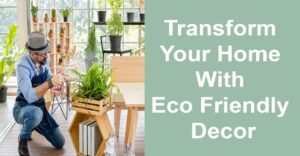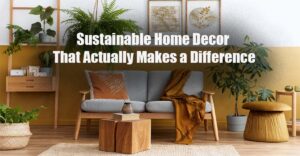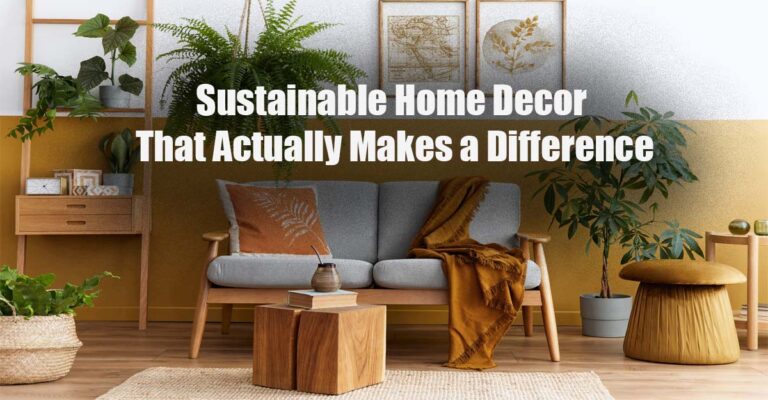To be honest, in 2025, the most stylish thing about your home will not be your gorgeous designer coffee table or cute throw pillows; it will be the fact that you decorated eco-consciously, and it didn’t cost the Earth. If it is possible to create a beautiful space while being mindful of Mother Earth, let’s get on with it! It is indeed possible, and it is also a beautiful way of life. The world of eco friendly home decor, where style and sustainability live happily together, is just around the bend, waiting for you.
It has long been the case that eco friendly home goods in the decor world have not always looked aesthetically pleasing, but that is simply not the case anymore. The current sustainable design movement is packed with imagination and vitality and has also received serious high-style ratings. There is a green path for everyone, whether you are a minimalist at heart or lavish by nature. Therefore, pack your reusable coffee cup, make yourself comfortable, and let us explore the ways through which your home can be turned into an environmentally aware paradise that even the best magazine would fight for to get a photo of.
Why Eco Friendly Decor Matters More Than Ever
Before delving into the delightful aspects, we should discuss the carbon footprint in your living room. If not directly, to put it another way, the impacts of the traditional home furnishings on the environment are enormous. There are numerous factors contributing to that impact, such as the fumes emitted by paints, the vast amounts of furniture thrown away that end up in landfills every year, and so on. All of these factors are interrelated with our decorating choices and the impact they have on the environment, which is more significant than we think.
The minimalist aesthetic is still the first one to go and lead the eco friendly trends by focusing on simplicity and functionality with a less-is-more philosophy. Now, the truth is—being sustainable does not mean being sparse or boring at all. It is reverting to quality instead of quantity, backing artisans instead of factories, and using the resources that nourish the earth rather than those that deplete it.
By purchasing eco friendly home goods, you are not only buying a product, but you are also voting for the kind of world you wish to inhabit. You are saying “yes” to the air in your place being cleaner, artisans working in healthier conditions, and the overall human activities causing less impact on the earth we all share.
The Natural Materials Revolution
Natural, eco friendly materials such as wood, stone, and clay are the primary elements of the eco friendly decor trend, and their raw and unprocessed textures depict the revival of nature and organic beauty. However, these materials are not just for Grandma’s hemp curtains that are rough and scratchy (no offense to Grandma, though). We are referring to beautiful organic cotton throws, bamboo furniture, and reclaimed wood items that evoke history and charm.
Bamboo has been the winner among sustainable materials for designers, and it is highly deserved. Bamboo is very lightweight and can withstand moisture and insects, while its very nature allows it to be compatible with different types of decor, like minimalist, tropical, or bohemian. This fast-growing plant is being used in eco friendly home furnishings for its durability and style. And every part of the house is involved, from flooring to furniture to blinds, etc.
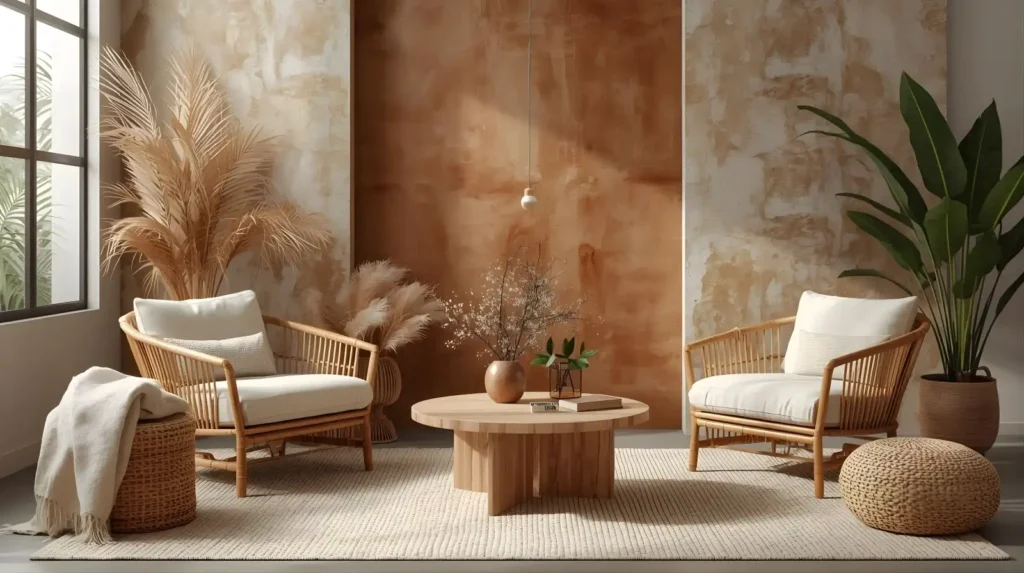
Next is reclaimed wood, which is the hero of the eco friendly home furnishings. Every single piece is a story in itself, and whether it is from old barns, shipping pallets, or deconstructed buildings, the source of the wood can always be traced back. The coffee table that is made from century-old barn wood is not just a piece of furniture; it is a conversation starter with a lot of character. If you’re using reclaimed wood, you can take pride in your choice for sustainability as well.
Natural fibres have finally arrived at their moment in the limelight. Cotton, linen, hemp, jute, and wool are now providing a very strong luxury in the home textile sector due to their presence. Their advantage over synthetic materials is not only the fact that they are biodegradable, but also that they are the ones developed using considerably less water and chemicals.
Cork, rattan, and wicker are materials that shouldn’t be neglected as well. Cork, which is the bark of the tree that regenerates, gives natural thermal and acoustic insulation, while at the same time, it adds a unique texture to walls and floors. These materials have been around for centuries because of their efficiency and durability, if catered to properly.
Sustainable Flooring That Makes a Statement
Let’s start from the ground up, shall we? Your floors are literally the base layer of your room’s style, so sustainable options here pack a punch.
When you think of bamboo, you might think of the orangey planks that we had back in the early 2000s, but just like the rest of the flooring world, bamboo has evolved light-years since then. Today’s bamboo floors look sophisticated in shades from honey blonde to brown/espresso, come in smooth and contemporary or wire-brushed rustic textured options, and are harder than most hardwoods available and seamless for heavy foot traffic. Plus, they have the warm, natural look that adds instant welcoming warmth to a space.
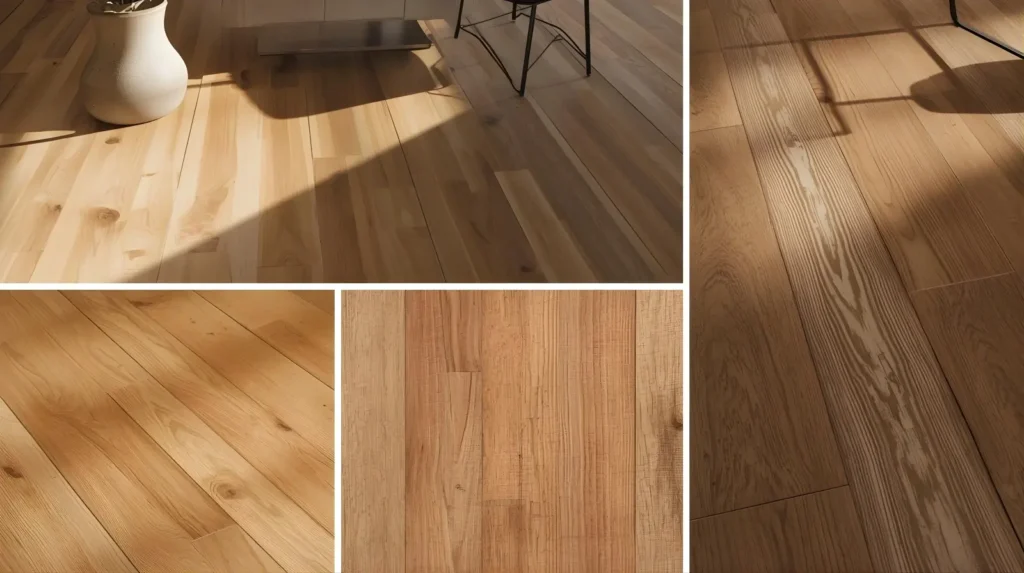
And cork flooring is having its renaissance moment, and quite frankly, it’s about time! This squishy, feel-good material is comfy to walk on if you are standing for long periods of time and naturally resists mould and mildew.
But if you’re craving the traditional hardwood feel, still don’t worry! Reclaimed hardwood flooring can feel traditional while still keeping usable materials out of landfills. If you purchase wide-plank antique or old strip oak from reclaimed buildings, it will be beautiful and have the story behind it and character that no new wood can replicate.
The Art of Upcycling and Repurposing
Now, this is the moment when eco-friendly decor becomes truly entertaining. The year 2025 sees maximalism not only making a way but also doing so through layering patterns, mixing eras, and accepting bold statement pieces along with vintage furniture from thrift shops, giving you the only treasures that are not found anywhere else.
Just think, that fifty-dollar dresser in the thrift store is just the right one for you? Just with some sandpaper, eco friendly paint, and new hardware, that dresser can be that statement piece your bedroom has been longing for. Old wooden ladders seem to be perfect for holding the blankets or plants. Mason jars can be used in the kitchen or bathroom for holding utensils and toiletries, respectively, and looking rustic at the same time.
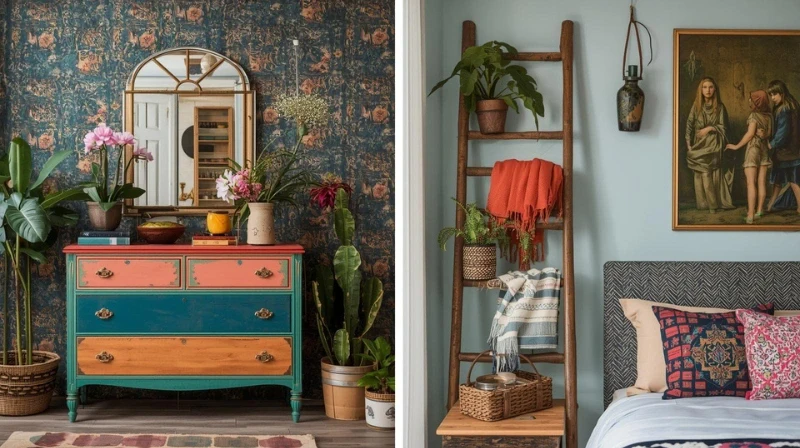
Upcycling is beautiful, as it compels you to spot the potential where others see merely trash. It not only stretches your creative abilities but also results in the creation of truly unique pieces. Your inimitable combo of vintage finds and DIY updates will be the one and only.
The concept of zero-waste decor is more philosophically sound than any other. The upcycling of old furniture, textiles, and materials, besides making new one,s is more and more the choice of homeowners, with vintage furniture getting new eco-friendly paint coats and rising as upcycled art pieces. Before you throw anything away, just ask: Could this be something else?
Bringing the Outside In: Biophilic Design
Biophilic design is the one trend that most accurately summarises eco friendly home decor. Nature is connected in all three ways with the help of biophilic design—plants, natural light, and living walls. The aesthetic that keeps nature close is not by accident but for our health and productivity. In other words, it’s the trendy term for what we all want and need—nature back in our lives.
Among other things, the first thing that one should do is to start with plants, glorious plants. Plants are not only good for the environment, as they improve air quality, but also bring a lively atmosphere into your home. Choosing the right plant for your place depends on your aesthetic and skill level, as there are plenty of options, like big fiddle-leaf figs to hanging pothos, pure snake plants to small succulents. Place them together in tropical wildness, put them in macramé hangers for bohemian style, or arrange them on floating shelves for sleek modern decor. The whole idea is to call and bring into your home living and breathing green nature.
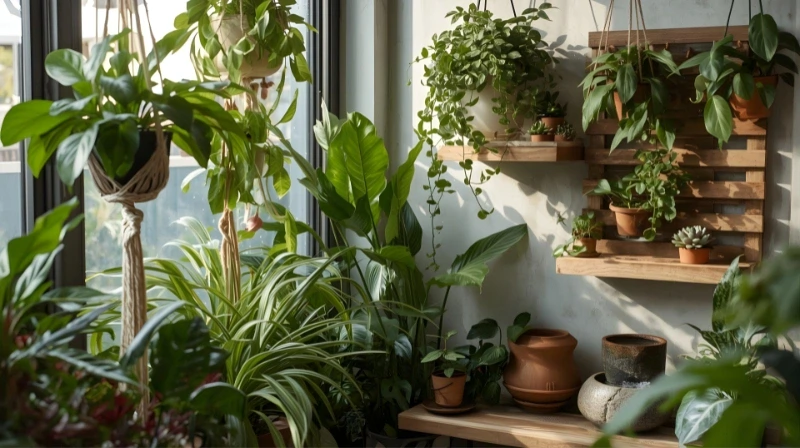
However, biophilic design is not limited to mere plant placement; it requires an entire strategy of nature reconnection through design choices. It entails the usage of natural textures like stone, wood, and clay. It also means picking colours that are inspired by nature.
A living wall can be seen as a very ambitious project; however, even a small vertical herb garden in your kitchen is equally good. The sound of a desktop water fountain can change your workspace into a calm and peaceful retreat. The main aim is to make the indoor and outdoor environments so similar that people cannot even tell where one stops and the other begins, thus forming areas that feel as if they are the natural continuity of the external world right outside your windows.
The Power of Sustainable Textiles
Let’s get ready to have a good time going through the different alternatives, as eco friendly home goods can never be full without eco friendly textiles. Organic cotton, hemp, bamboo, and recycled materials, among others, are quickly becoming the best options. These natural materials not only have less negative impact on the environment, but in many instances, they are even more comfortable and of higher quality than their synthetic counterparts.
Organic cotton will feel softer because it has not been exposed to harmful chemicals. Linen will improve over time, getting the very texture that no synthetic fiber can replicate. Hemp is very strong and naturally resists bacteria, and it makes a great upholstery fabric for daily use. Bamboo textiles have a beautiful drape and an amazing sheen that looks expensive, yet is at a low price.
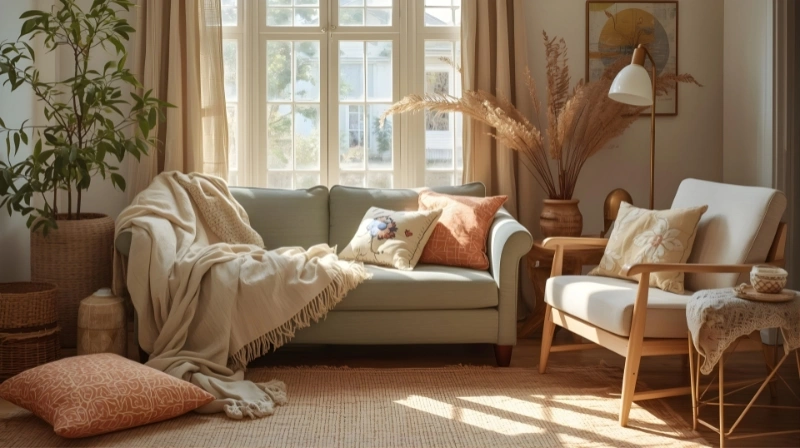
When it comes to pillows, curtains, bedding, or upholstered furniture, always go for natural fiber labels. They may cost more at the start, but you will not lose out on the health benefits of good air quality in your home and the prevention of microplastic waste from your washing. I call that a win-win-win situation.
Moreover, do not overlook the option of secondhand textiles, either. Vintage quilts, antique lace curtains, and retromania tablecloths. Tour estate sales, vintage stores, or Facebook Marketplace to discover your unique textile treasures and create instant character in your home. Just wash with eco friendly detergent, and let these textiles live another life in your home.
Lighting the Sustainable Way
The lighting is something that most people do not consider when thinking about eco friendly home furnishings. But the choices you make regarding lighting have a great influence on the energy you consume and the overall ambiance in your home. Solar-powered lights fit both the outdoor and indoor settings perfectly, while LED bulbs consume less power and have a longer life span than traditional bulbs.
The evolution of LED bulbs has been very considerable since their early days of harsh, blue-toned light. The current-day LEDs are available in warm, flattering light in different color temperature ranges to match any mood or task. They can last for many years (in some cases even decades), consume just a small part of the energy of incandescent bulbs, and do not have mercury like compact fluorescents.
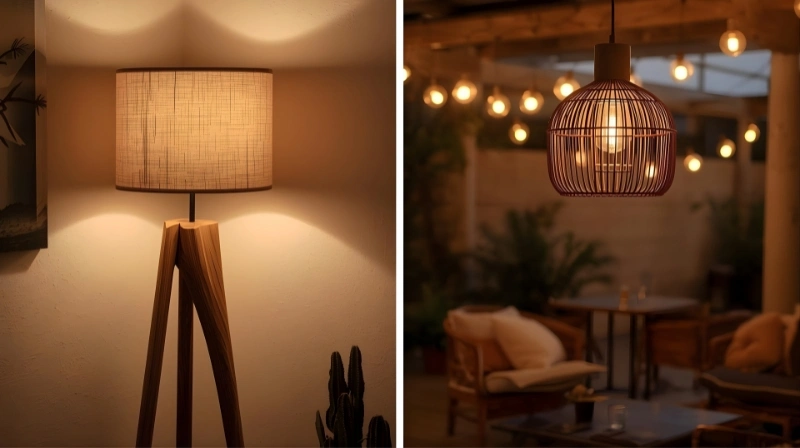
But do not limit your thinking to bulbs; think about fixtures as well. Try to find the lamps and the light fixtures that are made with sustainable decor materials such as reclaimed wood, recycled metal, or natural fibers. Eco friendly pendant lights with woven shades, floor lamps with wooden bases, or sconces made from repurposed industrial materials not only create that green decor aesthetic but also provide beautiful, functional lighting.
The solar lighting for outdoor areas has surprisingly become very sophisticated. No more weak pathway lights that hardly emit any glow. The solar technology of today offers options such as string lights for patios, spotlights for landscaping, and even chandeliers for covered outdoor dining areas.
Eco Friendly Paint and Finishes
The paint is definitely one of the biggest issues, as it contributes to covering the walls in a house. The use of conventional paints can lead to the release of hazardous volatile organic compounds, which are carcinogenic, thus contributing to the unpleasant smell of freshly painted areas. These VOCs will be off-gassing for months or even years after the painting, hence making your walls slow chemical emitters.
The positive aspect is that the practice of using low-VOC and zero-VOC paints has become the norm in the industry. Moreover, they come in every imaginable colour. Such paints are produced by employing water as a base rather than petroleum solvents, which greatly reduces their harmfulness to you, your family, and the environment.
More paint companies that use natural ingredients such as clay, milk protein, or plant-based resins and pigments are being considered. In addition, many natural paints actually improve with age, as they can acquire richer and more complex colours over time.
This is also true for wood finishes, stains, and sealers. Always opt for water-based products rather than oil-based ones and seek low-VOC or plant-based items. Your furniture pieces require finishes that will not gradually contaminate the indoor air with toxins.
Supporting Artisans and Handmade Treasures
I will reveal to you the aspect of eco friendly home decor that I consider the most gratifying, and that is the opening up to different artisan-made goods. Eco friendly home decor has been created anew, and it is, to a large extent, through the discovery of the maker’s world, where the goods are eco friendly. The reemergence of handmade and artisan goods is not only a trend but also a significant movement where people buy one-of-a-kind pieces crafted through the use of local artisans’ traditional techniques, like pottery, woven baskets, hand-carved furniture, and custom wall art.
Buying something handmade means that besides getting an object, you are supporting someone’s survival, helping the art crafts’ very existence, and getting an object that has a real spirit. The goods were produced using techniques that have been taught for generations, have a past, and give a connection to the makers and the relevant cultures in a very special way.
Search for local artisans in places like craft fairs, farmers’ markets, or small shops in your vicinity. Look for online platforms that deal only with handcrafted items. When buying from international artists, keep an eye out for fair trade certifications that could assure you of the artisan’s good pay and working conditions.
The beauty of the artisan pieces lies in their imperfection. An object of pottery has a glaze that is slightly uneven, fabric woven by hand has a pattern that differs slightly in places, and a carved piece of wood has a uniquely characterful detail; none of these shortcomings are imperfections, rather they are features. They indicate that an individual was behind the making of this item, and that makes it a hundred times more intriguing than a product produced on an assembly line and just like thousands of others.
Creating a Sustainable Kitchen and Dining Space
The kitchens and dining areas are the typical places where eco friendly home goods are placed in your house. The first thought is the tableware, which will lead to disposing of plastic and melamine dishes and getting them replaced with ceramic, glass, bamboo, or stainless steel. In addition, the vintage dishes picked up from thrift stores or estate sales often have wonderful patterns and are made of heavy-duty material that even the modern ones can’t match.
The paper napkins can be swapped easily for the cloth ones that are made of either organic cotton or linen. They are more comfortable and elegant, and eventually will save you money after the initial cost. This applies to the kitchen towels, dishcloths, and cleaning rags as well. It is a good practice to keep the pantry staples in glass jars rather than in plastic containers. Not only does it help keep food fresh, but you also get your pantry a chic look as if straight out of a lifestyle blog.
The choice of bamboo or wooden utensils, cutting boards, and serving pieces will be a more sustainable option than that of plastic ones. They have natural antimicrobial characteristics; hence, they do not get smelly, and they add warmth to your kitchen.
Another area where you can adopt the sustainable style is the centrepiece of your dining table. Instead of spending a lot on flowers that only last a week, why not be creative and make small cuts from your garden, pick branches from your yard, or use potted herbs for cooking later? The use of natural elements such as pinecones, stones, or driftwood coming from seasonal fruits, plus candles in reusable glass holders, will be perfect for creating an atmosphere.
The Bedroom as a Sustainable Sanctuary
Your bedroom ought to be the place where your fantasies are born, and the use of eco friendly decoration is the most suitable approach to do that. The very first thing to do is to change your bedding; this is the one item that you interact with for one-third of your lifetime. Organic cotton, linen, or bamboo sheets are the best temperature regulators and will allow you to feel cool in summer and warm in winter.
Choose a natural latex mattress composed of organic cotton, wool, or similar eco friendly home decor, and forget about the ones made of petroleum that release toxins throughout their life cycle. The same thing goes for pillows; choose natural latex, buckwheat hulls, or organic cotton fill, which are the best alternatives to synthetic fibers.
As for furniture, search for solid wood installations created from sustainably logged timbers or reclaimed materials. A sturdy wooden bedstead, a dresser, or a nightstand can be worth your lifetime, and at the same time, it can be refinished or refreshed to meet your varying preferences. Let your money not go to waste on furniture made of composite wood or MDF, which is glued with formaldehyde-based adhesives, as they release chemicals over time.
The use of textile window treatments made of natural materials, such as organic cotton for curtains or bamboo for blinds, will not only beautify the area but also create an ambiance. To make the room feel warmer, place a wool or jute rug under the feet.
Sustainable Living Room Essentials
Since the living room in your house is the place where all activities take place—talks, movie nights, reading books, sleeping, guests, and so on—it must be the most costly area. When it comes to sofas, support the environment and choose frames made of wood certified from sustainable forests or re-used materials, cushions filled with organic latex or down alternatives made from recycled plastic, and fabric that is wrapped in organic cotton, linen, or hemp.
Furthermore, you may also want to contemplate the idea of reupholstering a vintage sofa. It has a durable hardwood angle made for longevity during that time, and you will be able to select the eco friendly fabric that you love the most. It sometimes costs less than purchasing a new one. This technique is also applicable to accent chairs, ottomans, and other upholstered furniture.
For tables, solid wood or reclaimed materials are the best choices. An old trunk can be turned into a perfect table with storage in it. Old crates can become bookshelves if they are stacked and tied together. Tree cutters can make rustic side tables from the branches or stumps, allowing nature in.
Get creative with the help of unique handmade pieces—woven baskets for blanket storage, porcelain vases for fresh flowers, wooden bowls for displaying, or textile art for your walls. The trick is to create your space bit by bit through pieces that are truly loved, instead of buying everything all at once from the same store where it is all perfectly matching but has no character.
Mindful Shopping for Eco Friendly Decor
The thing about genuine, sustainable, eco friendly home decor—it might be that the most environmentally conscious act is not buying anything at all. Before you purchase anything new, ask yourself: Do I really need this, or do I just want it because I am bored? Is there one on the secondhand market? If you decide to purchase a new item, then do your homework. Look for companies that value sustainability not just in their products but in their whole business model.
Look for certifications like FSC (Forest Stewardship Council), GOTS (Global Organic Textile Standard), Fair Trade, and CertiPUR for certified foam. Buy less, but buy better. One thing that lasts twenty years and is well-made is always better than five things that you paid nothing for that fall apart in two years.
Well-made things develop patina and character, ultimately becoming more beautiful over time, as opposed to just looking dingy as things get old. Use local whenever possible. Buying from local makers and shops reduces shipping emissions and supports the wealth of your community’s economy.
Embracing Imperfection and Personal Style
One surefire thing about eco friendly home accessories is that most of them are imperfect, and this makes them even more attractive. What are called “imperfections” are really the traits that give your house a warm feeling and genuineness. And just like the Japanese philosophy “wabi-sabi” teaches, imperfection, authenticity, and the natural cycle of growth and decay are what one should let be in beauty.
You can have different times, styles, and materials all in one place. A mid-century modern chair can be something spectacular, along with a rustic farmhouse table. Artists’ handmade ceramics from different places do not create a chaotic collection, even though they do not match perfectly. Rather than going after some Pinterest-perfect ideal where everything looks the same and no one can tell how long it has been there, accept the lived-in, collected-over-time aesthetic that indicates your life story.
Your place should be a reflection of yourself, not a carbon copy of a photo shoot. A gradual approach to the most beautiful and eco-friendly spaces is by allowing pieces of significant and purposeful value to accumulate naturally over time.
Making It All Come Together: Your Home, Your Legacy
Transforming your space through eco friendly decor is not an overnight process; rather, it is about gradually putting together a collection of items that are in tune with you, that have their own tales, and that are durable. It is about the “intentional” part of your choices and the “patience” part of your progress.
Begin with small steps—possibly, next time you refresh your room, choose low-VOC paints instead of conventional ones, or get pillows made of organic cotton instead of synthetics. It is okay to use the existing decor while switching to more sustainable ones.
The nice thing about this method is that you will have a space that honestly showcases your values and becomes a living symbol of your commitment to sustainability, creativity, and conscious living. Every item will have a reason for being there, whether it is the tale of where you got it, the craftsman who produced it, or the experiences linked to it.
So, feel free to start that transformation. Look for beautiful things at the nearest second-hand store. Request a custom piece from a local woodworker. Grow that indoor herb garden you have been fantasising about. Every minor decision contributes to a major difference, not only for your space but also for the Earth.
Congratulations on the start of something gorgeous—the eco friendly decor saga that is your story and is much larger than just beautiful places. You are making a history of caring choices, a home that is alive with the future, and an impact that reaches beyond your four walls.
Eco-Friendly Decor: Frequently Asked Questions
What is eco-friendly decor?
Eco-friendly decor refers to home furnishings and accessories made from sustainable, natural, or recycled materials. It focuses on reducing environmental impact while creating a stylish and healthy living space.
Why should I choose eco-friendly decor for my home?
Choosing eco-friendly decor lowers your carbon footprint, supports ethical manufacturing, and avoids harmful chemicals found in conventional products, promoting a healthier home environment.
What materials are commonly used in eco-friendly decor?
Common materials include reclaimed wood, bamboo, organic cotton, recycled glass, natural fibers, and non-toxic paints. These are renewable, durable, and environmentally responsible.
How can I make my home more eco-friendly with decor?
You can make your home eco-friendly by incorporating energy-efficient lighting, sustainable furniture, upcycled items, indoor plants, and accessories made from natural or recycled materials.
Is eco-friendly decor more expensive than regular decor?
While some eco-friendly products may cost more upfront, they tend to be more durable and energy-efficient, saving money over time and providing long-term environmental benefits.

